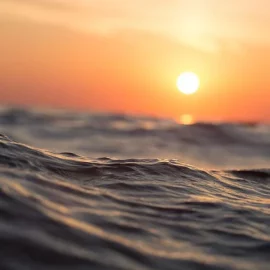
No, this is not the “heat island” effect I am talking about but it may feel like this in New Orleans. The heat rising from the asphalt, the streets, and the sidewalks.
Over her lifetime in New Orleans, Angela Chalk has noticed her 7th Ward neighborhood heating up as the number of trees diminished. “Everyone is aware that it’s hot,” Chalk said. “They may not specifically know the reasoning for the increased temperatures.” The same asphalt and concrete that contribute to flooding also absorb and retain the sun’s rays, then slowly radiate that heat back into the air. This creates “heat islands,” keeping the air hotter for longer periods in some spots and for those spots exacerbating the extreme heat that affects broader regions. It’s the second, site-specific part of a one-two punch in an era of rising temperatures across the globe. Due to a combination of dark and impermeable surfaces, New Orleans ranks as the worst heat island of 159 cities in the United States, according to a new report from science news nonprofit Climate Central — more intense than even larger metropolises such as New York City, Houston and Chicago. Lafayette ranks 19th. “It’s additive,” said Andrew Pershing, the nonprofit’s director of climate science. “Whatever the temperature you have on that day, you have this extra effect.”
nola.com
9 degrees, that is what the increased temperature we feel is greater than outside the city. The less trees, the more it could increase. Minority and low income residents feel it more as they live in areas with less tree cover.
Extreme heat can trigger potentially fatal reactions such as heat stroke or exhaustion, and worsen a range of health issues, from respiratory illnesses to heart diseases. It also is expensive, driving up energy costs to cool houses and businesses. Amy Lesen, a Dillard University health-disparities researcher who was not involved in the Climate Center analysis, said the report is built on well-established research into the factors creating urban heat islands. She was surprised to see New Orleans at the top of the list, but she said it’s time to go beyond broad models and to measure just how much temperatures vary across the city. “This is a good wake-up call, and we need to think about it,” Lesen said. “We also really need to dig down into what the reality is on the street for people [who] live here.”
Cities need to design ways to cool down as temperatures are rising even without the “heat island” effect.
Pershing said the report aims to highlight changes that a city can make to cool itself. “We know that cities are getting warmer and they’re going to continue to get warmer over the next several decades,” he said. “ But … you have the potential where you can actually make changes that essentially reduce the warming that people will experience.” For New Orleans, that means reckoning with the high concentration of impermeable surfaces with low albedo, a measure of how well a material reflects solar energy; lighter and more reflective surfaces have higher albedo. Pershing said cities can add more reflective surfaces and ensure that the effects of darker surfaces are mitigated with green spaces.
New Orleans has started. The mayor want to increase trees and parks, to increase amount of green and permeable space, by up to half again the current status.
In the 7th Ward, Chalk founded Healthy Community Services to regreen her neighborhood. Partnering with Dillard, Tulane University’s Bywater Institute and other organizations, the nonprofit hopes to lessen the heat and reduce flooding. Much of its work involves educating residents on green infrastructure and planting trees. Chalk said she’s monitoring results with sensors to compare an area with new trees to an untouched section. “We know that we’re cooling down incrementally,” Chalk said. “It’s going to take a while for them to come to full maturity so that you can have some recognizable benefits.” ISeeChange, a New Orleans-based climate technology company, also is trying to map heat throughout the city with sensors and user-generated data. That’s the kind of community-based work that Lesen, the Dillard researcher, wants to promote to address New Orleans’ heat islands. “What’s really valuable here is talking about what the impacts are,” she said, “and then thinking about how they can be improved.”
TOP 20 URBAN HEAT ISLANDS
- New Orleans, 8.94 degrees
- Newark, N.J., 7.71 degrees
- New York City, 7.62 degrees
- Houston, 7.46 degrees
- San Francisco, 7.37 degrees
- Boston, 7.24 degrees
- Chicago, 7.24 degrees
- Miami, 7.24 degrees
- Baltimore, 7.08 degrees
- Providence, R.I., 7.08 degrees
- Sacramento, Calif., 7.08 degrees
- Salinas, Calif., 7.08 degrees
- Burlington, Vt., 7.05 degrees
- Bend, Ore., 6.97 degrees
- Cleveland, 6.97 degrees
- Detroit, 6.97 degrees
- Erie, 6.97 degrees
- Fresno, Calif., 6.97 degrees
- Lafayette, 6.97 degrees
- McAllen, Texas, 6.97 degrees
Source: Climate Central.
As you can see, not only are we at the top, but by over one degree. We definitely need changes. I just put another tree in my back yard and will do another one in the front. The back yard is hot, but shade is developing.



